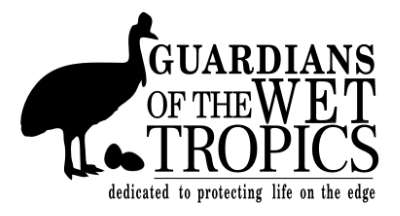Guardians News
Wildnet Frustrations
By Ingrid Marker, Cassowary Keystone Conservation / Guardians of the Wet Tropics
3 October 2023
Scientists, researchers, naturists, citizen scientists and conservationists alike have all been encouraged to report threatened species sightings to the Department of Environment and Science (DES) or to enter their observations in Wildnet directly as the official Government portal for storing threatened species data. This data is used for State Government approvals or NOT for development applications or for placing Nature Refuges or Voluntary Declaration Covenants (VDec) over private parcels of land.
For 33 years I’ve been researching cassowaries and nine years of giving all my data to DES to upload into Wildnet, I now NEEDED my cassowary data to secure a Vdec for my property, (a known cassowary hotspot), from the official Government portal. NO CASSOWARY REPORTED to live at this site. Wildnet had none of my data.
I did a deep dive and found the issue repeated across the State failing all threatened species, all groups have expressed frustration towards WildNet and decided to use other portals that don’t influence planning decisions for the State. Due to insufficient data many environmental damaging developments were being approved and private property protection like Vdec’s etc not getting the environmental protections they needed due to Wildnet data failings. Was this a convenient but devious means by Government to have business as usual?
I have been lobbying and researching below is what I have learnt to date:
The central database for threatened species projects needs urgent improvements.
- The WildNet database, built in 1997, is its centralised data platform. It relies on manual processes for curating, loading, managing, and sharing information.
- The department does not have any data management protocols to guide how data on animals and plants is stored, managed, and distributed. Not all teams that undertake threatened species activities provide monitoring data to the department’s Science Division, which manages WildNet (the department’s database for recording wildlife sightings and listings in Queensland).
- All complain about how difficult it is to get the data back from WildNet in the form they require to inform their conservation action planning.
- In 2018, the department did not have agreements or processes in place for gathering and processing threatened species data into a central database to improve its monitoring and reporting.
- There is a backlog of wildlife data.
- The department’s database for recording wildlife listing and sightings in Queensland is still not complete or up to date. The department has a significant backlog in information (approximately 10 million records) that it needs to upload. As a result, this information is not readily available to inform decisions.
WildNet does not have the functionality to easily show trends or changes in population abundance over time for all threatened species. Where it does collect monitoring data on species, the department has provided it to the Threatened Species Index, which provides nationally comparable measures of change in the relative abundance of Australia’s threatened and near-threatened animals and plants. To date, the department has contributed monitoring data on 11 animals to the index and no plants.
Future commitments made.
As an initial step towards developing a framework for monitoring and reporting of threatened species, the department started compiling an inventory of threatened species projects across its different divisions.
In late 2020, the department developed its WildNet System Strategy (2020-2025) to prioritise business demands and inform upgrades. The strategy was developed in late 2020. It provides a set of focus areas and a roadmap for modernisation activities. Modernising WildNet includes:
- initiatives to consolidate biodiversity systems and new data management capabilities and infrastructure through theAccelerating Science Delivery Innovation Program
- a biodiversity data repository, funded from The Australian Government Digital Environmental Assessment Program.
The goal is to design and implement a comprehensive data platform for threatened species by the end of 2024. This could enable the department to consolidate threatened species data in an online repository, giving it an interactive, visual tool to perform data analytics.
WildNet Modernisation Project.
Recent advice to me is that. “The project’s mandate is to transform WildNet into a new modern biodiversity data repository to support government, industry, and the community. It is hoped it can deliver an improved system that will overcome the current ageing technology and processing inefficiencies. The new system will be built on scalable architecture in Azure and aligned to the QESD Data Platform and best practices prescribed by Microsoft/Azure delivered by 2024.”
Guardians of the Wet Tropics needs your help to keep them on track to deliver on their promise.
Direct your concerns to: WildNet WildNet@des.qld.gov.au
Find out more about Wildnet database:https://www.qld.gov.au/environment/plants-animals/species-information/wildnet
I acknowledge the Traditional Owners and Custodians of the lands and waters of Australia. I pay my respects to Aboriginal and Torres Strait Islander Elders past and present and future, aspiring to learn from their traditional knowledge to help nature thrive and understand our place in it.
